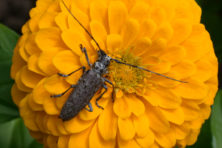Robosquirrels and Dung Beetles
- Share
- Tweet
- Pin
- Share
• A team of researchers in California studied the interaction between ground squirrels and their main predator, rattlesnakes. These squirrels have evolved behaviors to thwart being eaten by the snakes. When a squirrel sees a rattler, it approaches it head first, body low to the ground, and with its tail sticking up in the air. Two things happen: the tip of the tail flicks back and forth and blood is diverted to heat the end of the tail. Rattlesnakes target prey by using infrared sensors to detect body heat. If the snake strikes, it usually misses because it has homed in on a warm and wagging tail sticking up in the air, and the squirrel quickly jumps out of the way. Sometimes during snake/squirrel encounters, the rattlesnake doesn’t even bother to engage the squirrel, for it knows it has met its match. How did the researchers obtain all this information? They built a robotic ground squirrel that could be directed by remote control. The robosquirrel could even heat the end of its tail during an encounter, and just like the real thing, the robosquirrel almost always survived. When the researchers forgot to raise the robosquirrel’s tail, its body sustained a nasty snakebite. (ScienceDaily, April 3, 2012)
• In Texas, dung beetles are said to consume over 80 percent of the droppings left by cattle herds. Some kinds build a nest of tunnels just beneath the fecal pile, bite off pieces of dung, and drag the pieces deep into one of the tunnels. There a female lays an egg on a piece of dung and rolls it into a ball. Eventually, the egg hatches, and the larval stage eats the dung on its way out of the ball to become an adult. Other kinds of beetles build their tunnels at some distance from the dung pile, and push balls of feces along the ground and into their tunnels.
In Africa several thousand dung beetles may show up to feast on a fresh elephant dropping. Finally, a recent study indicates that dung beetles are partial to the smelliest poop available, with human and chimp dung at the top of the list. (Gullan and Cranston, 2005, The Insects, Blackwell Pub.; Science Daily, April 3, 2012; Live Science, April 13, 2012)
• Science has now shown that a vigorous run can result in the brain releasing hormones called endorphins that give the runner a feeling of pleasure that has been described as “runner’s high.” These naturally occurring opiates have much the same effect as marijuana. One recent study showed that the blood level of endorphins in a runner’s blood increased by 60 percent after running for 30 minutes. Running dogs showed an even greater increase in endorphin release. Did the release of endorphins help our ancient ancestors outrun slower-footed predators? (The Economist, April 24, 2012)
• Research indicates there are several kinds of food that appear to provide a boost to brain function. Here is a list worth considering:
– Cold-water fish, which are rich in omega-3 fatty acids.
– Blueberries are loaded with antioxidants.
– Vitamin D-fortified foods; one study showed that three out of four people have sub-optimal levels, especially in older adults. The vitamin is provided by exposure to sunshine, fatty fish, mushrooms, fortified milk, and egg yolk.
– Regular coffee may help lower risk for dementia. Among 1,400 people followed for 20 years, 66 percent were less likely to develop dementia than non-coffee-drinkers.
– Garlic…a powerful antioxidant.
(Mind, Mood & Memory, Mass. General Hospital, April issue, 1912)


